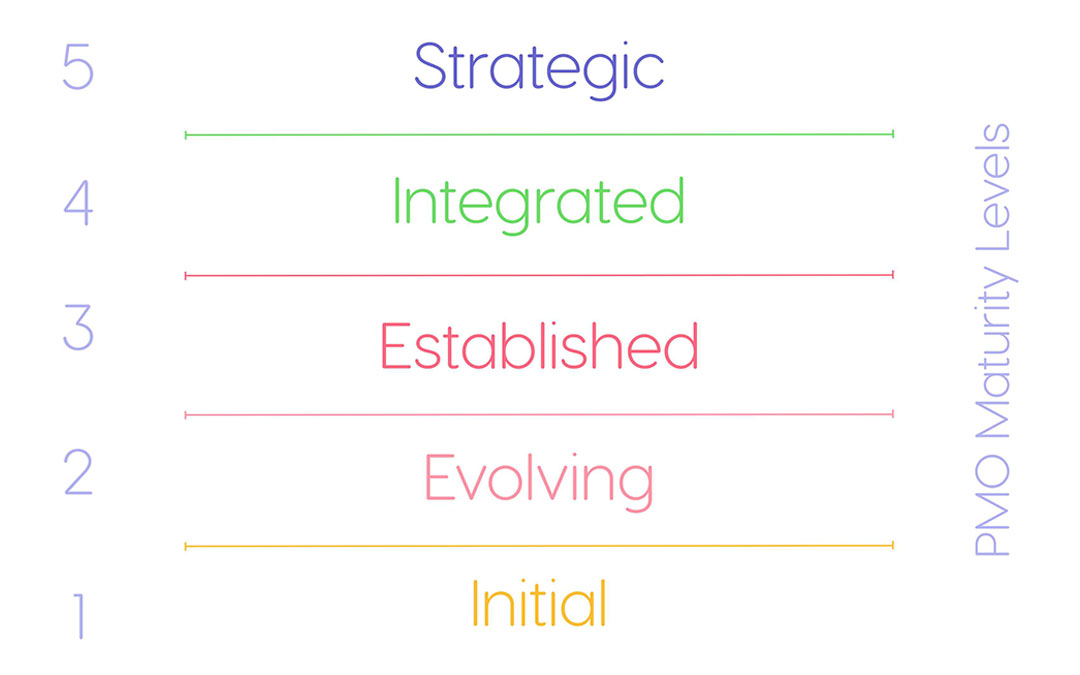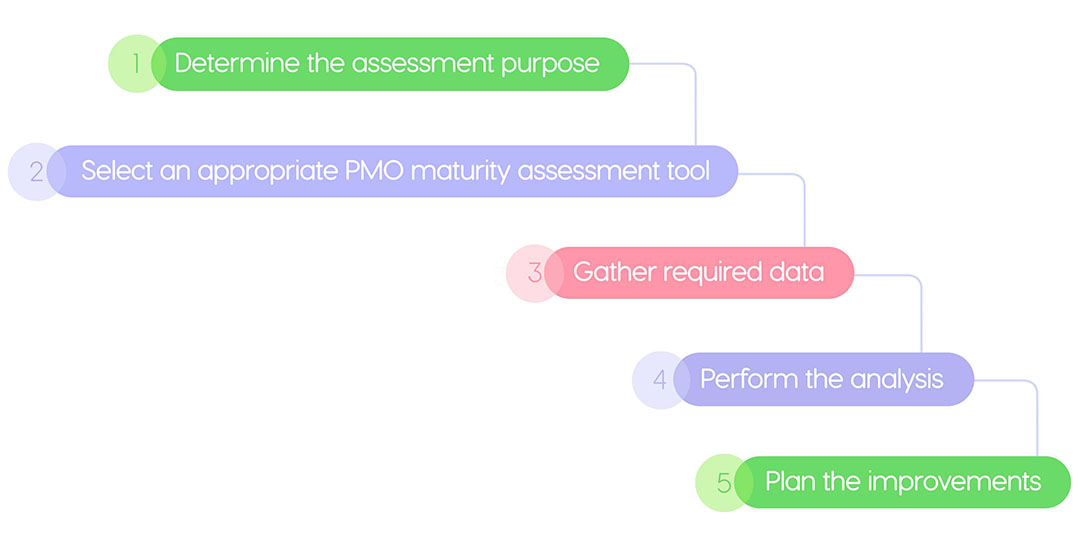
Sometimes, the PMO doesn’t deliver the results expected, despite all the efforts. Why is this happening? What areas of PMO work can be improved? How to increase the project management maturity level of your PMO? Using PMO maturity models will give you answers to these questions. These models help not only assess the current level of your project management office, but also provide you with guidelines on how to improve the situation.
Read the article to learn what PMO maturity models are, how they work, and how they can increase the performance of a project management office.
What Is a PMO Maturity Model?
PMO maturity model is a framework used to assess and increase the performance of a project management office. These models provide a step-by-step guidance on how PMOs can improve over time. Why is that important? According to PwC, mature project management offices become “problem solvers, enablers, and motivators”.
This means that increasing a PMO’s maturity level will have a positive impact not only on the project management office itself, but on the entire organization.
In one of our articles, we’ve considered project management maturity models. But do they actually differ from PMO maturity models? Yes, they aren’t the same: a PMO maturity model focuses on the work of a project management office, while PM maturity models consider the ability to manage projects of the entire organization or its multiple departments.
Key aspects of PMO maturity models
As a rule, a PMO maturity model embraces the following components.
- PMO levels of maturity: Stages of PMO development, from initial to advanced.
- Criteria for PMO assessment: What aspects will you rely on when assessing PMO maturity level?
- Recommendations: What actions should you take to proceed to the next level of maturity?
Let’s now review in detail why these models are so important, and how your organization can benefit from using them.
Benefits of Using a Project Management Office Maturity Model
No matter what level of maturity your PMO has, leveraging maturity models will help it in the following ways.
1. Current PMO maturity assessment.
Thanks to PMO maturity models, organizations can compare the way they’re working on projects with other organizations’ practices and standards. Based on this comparison, you can identify gaps and inefficiencies in your PMO that can be improved.
2. Insight into improvements.
Maturity models provide a roadmap for improving processes, implementing techniques and tools to achieve higher levels of performance. This helps PMOs streamline their work and standardize processes.
3. Improved project performance.
Probably, this is the main goal of all improvements made to the project management process. Implementing maturity models is no exception. Having identified the gaps and following the roadmap suggested by a maturity model, you can reduce project failures and increase project success rates.
Now, let’s review the typical levels of a PMO maturity matrix.
The 5 PMO Maturity Levels
If we summarize the existing maturity models, their levels can be represented as follows.
Level 1: Initial.
This PMO maturity level is also known as ad hoc. Here are some brief characteristics of this level:
- PMOs don’t have clearly defined processes, resource and budget management processes are rather intuitive than purposeful.
- There’s a low level of coordination between projects running in a company.
- There can be no reporting or formal documentation within a PMO.
Obviously, with this low level of PMO maturity, it will be difficult to achieve seamless work on projects and desired outcomes. It will more likely lead to delays, improper utilization of available resources and budget, and reduced project performance.
Level 2: Evolving.
At this level, PMO has a certain influence on the organization. However, it’s still limited and not effective enough. In particular,
- PMO oversees some basic project and resource management processes.
- At the same time, project selection process is not mature enough and may be affected by office politics.
For example, a company may adopt resource management software to take resource management under control, but success of its adoption may vary depending on how effectively different departments use this tool.
Level 3: Established.
This level is characterized by more consistency; PMO becomes an essential department within the organization. At this level, PMO has the following impact:
- It establishes a project management methodology for all projects;
- It provides required documentation and training;
- It prioritizes projects based on business value and business goals.
- It is characterized by the higher level of portfolio visibility, resource planning, risk management, and other essential PM processes.
Level 4: Integrated.
This is a rather mature level of PMO development. At this level, PMO becomes an integral part of an organization, controls all project management processes, and supports the execution of business strategy. Here are the main characteristics of this level:
- PMO uses specific tools to achieve enterprise-wide visibility and analytics.
- PMO makes decisions based on data, not on assumptions.
- PMO plans resources for future projects.
Level 5: Strategic.
This is the most advanced level of PMO maturity. At this level, PMOs ensure not only high project performance, but become an essential driver of high organizational performance and business success. They work closely with C-level executives, support their decision-making, and ensure that projects run by an organization contribute to executing its business strategy.
This was a summary of the PMO maturity levels found in the majority of models. Now, it’s time to get to know the existing models themselves.
Popular PMO Maturity Models (With Examples)
The PMO maturity model examples are diverse. Most of them are project management maturity models, but they are also suitable for project management offices. Let’s consider them in more detail.
1. PMO Maturity Cube.
The PMO Maturity Cube is designed specifically for project management offices. It takes a multi-dimensional approach to maturity development. The three dimensions of this maturity cube are as follows:
- Scope: enterprise, departmental, program/project;
- Approach: strategic, tactical, operational;
- Maturity level: basic, intermediate, advanced.
For each PMO scope, the framework has a specific questionnaire that helps determine what services match each of the approach and at what level. This is a self-assessment tool that helps PMOs determine their current maturity and identify the areas for further development.
2. Organizational Project Management Maturity Model.
OPM3 model is considered as a standard developed by the Project Management Institute, as it was created based on the PMBOK Guide. It embraces project, program, and portfolio management, which means that it can be used by organizations of all sizes. It contains a list of questions for self-assessment and recommendations on achieving project management maturity. This model proposes four stages of increasing maturity: standardization, measurement, control, and continuous improvement.
The benefits of this model are as follows:
- It’s based on practical experience of project managers and consultants.
- It helps organizations execute their business strategy.
- It provides the analysis of existing gaps and shows areas for improvement.
Finally, continuous improvement will provide organizations with long-term benefits; this will provide them with opportunities to constantly increase their maturity level and improve their project and business outcomes. The disadvantage of this model is that it’s not flexible enough, rather complex, and requires PMI-certified professionals to be implemented.
2. The Portfolio, Program, and Project Management Maturity Model.
P3M3 is also a versatile model that focuses on project, program, and portfolio maturity. Compared to the previous model that is designed for companies leveraging a classic approach to project management, it can be used for every PM methodology.
The model consists of three smaller frameworks for project, program, and portfolio management. PM maturity is evaluated across 7 dimensions:
- Organizational governance,
- Management control,
- Benefits management,
- Risk management,
- Stakeholder management
- Finance management.
- Resource management.
What are the advantages of this model? First, it helps assess current maturity objectively using the scoring system. Secondly, it embraces all project management levels. Thirdly, it’s rather flexible. However, this model can be rather complex in implementation, especially for newly established PMOs, and companies may require external support.
3. The Project Management Maturity Model by PM Solutions.
This model was developed by PM Solutions, which is a consultancy company. This model consists of two dimensions. The first one corresponds to 10 Knowledge Areas from the PMBOK Guide (the management of scope, time, budget, quality, resources, communications, risks, procurement, stakeholders as well as project integration management). The second dimension determines the 5 maturity levels:
- Initial process;
- Structured process and standards;
- Organizational standards and institutionalized process;
- Managed process;
- Optimizing process.
Also, the model has assessment framework and a guide helping business organizations improve their project management maturity and proceed from level to level.
The advantage of this model is its simplicity, compared to the previous frameworks, and practicality. At the same time, there isn’t enough focus on strategy execution, so it’s rather suitable for PMOs that prioritize project performance and standardization.
5. Kerzner Project Management Maturity Assessment.
This is a widely known PM maturity framework developed by Harold Kerzner. Like most maturity models, it consists of five levels, but they are described differently:
- Common language;
- Common processes;
- Singular methodology;
- Benchmarking;
- Continuous improvement.
This model helps you assess your organization’s performance and current state of its project management processes across the above-mentioned five levels. In addition, it takes into account three important variables: visibility, consistency, and control. Using this maturity assessment framework, you can score your PMO processes’ state and get recommendations on how to improve it.
The advantage of this maturity assessment is that widely applicable and easy to use. However, it may be less suitable for complex multi-project environments that require strong focus on strategy execution.
How to Assess Your PMO’s Maturity: 5 Steps
Increasing your PMO maturity levels is impossible without determining its current state. This is the basis for effective model adoption, so you should pay particular attention to it. Here are the main steps in this process.
Step 1. Determine the assessment purpose.
First things first: you should clearly understand why you need this maturity assessment. For example, you may need to find inefficiencies or assess particular areas (e.g., resource utilization, stakeholder involvement, etc.). Determining the goals before starting the project management office assessment will help you keep focus on important things and quickly spot the trouble areas.
Step 2. Select an appropriate PMO maturity assessment tool.
Each of the models has its own specificity. For example, if you stick to standard project management approach based on PMBOK, it will be more reasonable to apply OPM3 model, while P3M3 helps assess the enterprise-level maturity.
Step 3. Gather required data.
The analysis of the current maturity state should be based on data. Therefore, you should collect it across the key areas. These areas can be included in the maturity model, but you can also select them depending on your organization’s needs. Basically, these areas may include the following ones:
- Project/portfolio performance;
- Resource performance
- Alignment with business goals;
- Interaction with stakeholders;
- The use of portfolio management tools;
- The effectiveness of risk management;
- Budget management;
- Benefits management, and more.
You can collect all the required information using interviews, questionnaires, internal documents, dashboards provided by project portfolio management software, analysis of reports, etc.
Step 4. Perform the analysis.
You can assign scores to each of the areas or determine their maturity level (ad hoc, developing, etc.). In some maturity models, there are specific guidelines for performing this analysis.
Having conducted the analysis, you can also identify gaps and areas where improvements are required, which will later become the basis for increasing the overall PMO maturity level.
Step 5. Plan the improvements.
Finally, you can use your findings to develop a roadmap for further improvements. Based on the selected model, set the specific goals (both short and long-term). Set priorities to increase the effectiveness of implementing changes. When these initiatives are prioritized, you won’t spread your efforts too thin, trying to improve everything at once, but dedicate all your attention to each area step-by-step. Finally, you should assign people responsible for implementing improvements and monitor these processes regularly.
Read more: Top 4 Challenges for a Project Management Office (PMO) and Ways to Address Them
Final Words
A PMO maturity model becomes an actionable tool when you need to understand what holds back the PMO’s performance. Using them, you can objectively assess the state of your PMO, detect what areas need improvement, and implement these improvements consistently.
In addition to using a PMO maturity roadmap, you need to make sure that your project management office uses the right PMO tools. To ensure high portfolio performance, they should have the following key capabilities:
- A bird’s eye view of the entire project portfolio;
- Smart resource management capabilities: resource capacity planning, resource allocation, workload management, etc.;
- Project and task prioritization;
- Budget and risk management;
- Scenario planning for optimum decision-making.
These and other functionalities are available in Epicflow, mutli-project resource management software for PMOs. Companies leveraging Epicflow can dramatically increase their portfolio performance without allocating extra people and spending extra costs. Want to learn how? Book a call with our professionals, and they will show you the magic happening in your multi-project environment.
Frequently Asked Questions
What is the PMO maturity model?
A PMO maturity model is a tool that helps companies evaluate and improve the performance of their PMOs. Usually, they consist of a questionnaire for current maturity assessment and offer concrete steps that allow you to enhance maturity at each level. The adoption of PMO maturity models helps companies improve portfolio performance and has a positive impact on their business outcomes.
What are the 5 levels of PMO maturity?
Though maturity models are different, typically they offer 5 levels of maturity reflecting the state of a PMO and offering the direction for moving further. These levels are:
- Initial,
- Evolving,
- Established,
- Integrated,
- Strategic.
The names of these levels will vary from one model to another, but the essence remains.
What are the most popular PMO maturity models?
You can hardly find a lot of maturity models designed specifically for PMOs. However, some of project management maturity models are perfect for increasing PMO maturity as well. For example:
- PMO Maturity Cube;
- Organizational Project Management Maturity Model;
- The Portfolio, Program, and Project Management Maturity Model;
- PM Solutions Project Management Maturity Model;
- Kerzner’s Project Management Maturity Assessment.
Also, there are some tailored PMO assessment frameworks (e.g., PMO capability maturity model), which can be used for a company’s specific purposes.









